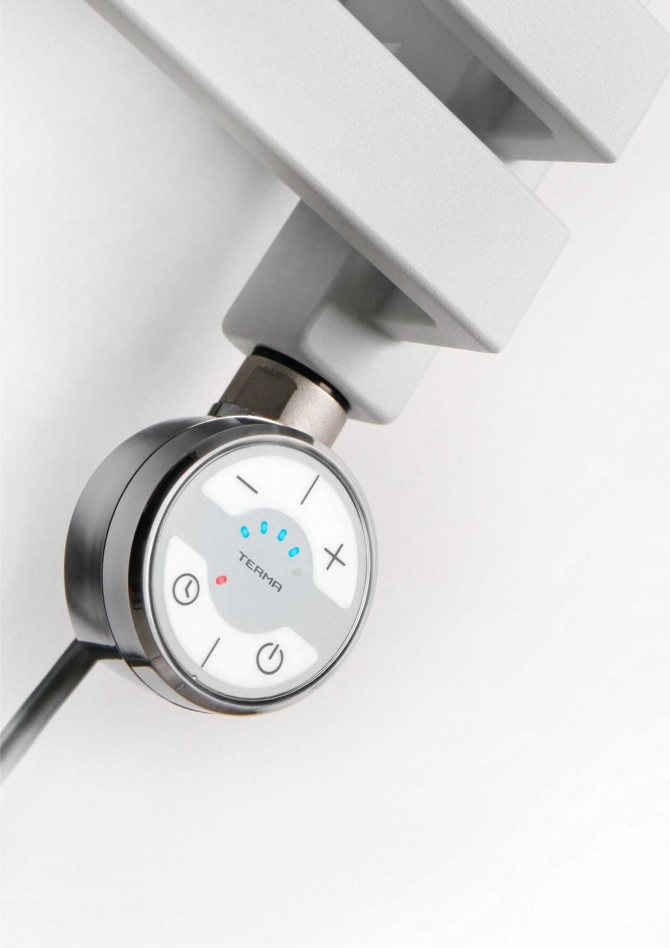Electric heating elements have not changed their design for decades and remain in demand in heating equipment. The shape of these devices, construction materials are changing, but the principle of operation and efficiency remain unchanged. For a competent selection, information about the differences and characteristics is useful. Do you agree?
You will learn what they are and how heating elements work for heating. We described in detail the types of heating elements, gave indisputable arguments for a reasonable choice of the optimal type. Taking into account our recommendations, you will acquire the required device without errors.
Purpose of heating heating elements
Electric heating elements have gained popularity due to their versatility and high efficiency. All the electricity they consume is used for their intended purpose - to heat the surrounding space.
The main heating devices where heating elements are used are:
- Portable and stationary electric oil heaters.
- Water heating radiators.
- Heated towel rails for the bathroom.
- Electric fireplaces.
- Electric convectors.
- Electric boilers.
The specified equipment can be used as a primary or additional heating source. It is inexpensive, easy to install and does not require special skills during operation.
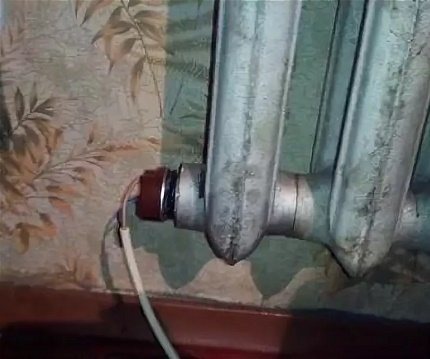
You can connect the heating element to a cast-iron central heating radiator after disconnecting the common riser. Such a device can be used for main and additional heating.
What is a heating element for heating?
Electric heating elements are heating elements that are placed in the liquid inside the radiator. They heat a liquid: water, oil or a special agent circulating through the heating system. Passing through the pipes, the heated liquid gives off heat to the environment and returns back to the heating element. They can be installed in hot water radiators, infrared heaters, or in heating boilers. Heating elements of various types and modifications are produced. In all of them, the heating element is reliably protected from water ingress and is additionally covered with a galvanizing layer. All of these measures serve to prevent accidental electric shock to people.


Internal arrangement of electric heaters
It is convenient to consider the device on the example of a tubular model. An electric heater is a ceramic or metal tube filled with a thermal conductor with a spiral located inside. In the place where the tube is fixed to the flange, there are insulating bushings that make it impossible for the conductive spiral to contact the heating element body.


In most models of heating elements, similar components are used, however, their durability may differ depending on the build quality
The electric heater is fastened mainly with a flange connection, which makes it possible to seal the internal environment of the heater from the external space. The disadvantage of this design is the impossibility of replacing the coil when it burns out internally.
The principle of operation of heating elements
The heating element works according to the following principle. When connected to the network, the inner coil is heated and energy is transferred to the thermal conductor and the outer sheath. Subsequently, heat is transferred to the surrounding liquid, air or solid material.
When heating a heating element immersed in oil or water, convection flows are created around the tube, which mix the coolant and contribute to its uniform heating.


Electric boilers are renowned for their reliability and maintainability. They do not have many complex parts, so they are easy to operate and maintain.
In non-liquid heaters, the heating temperature is usually limited so as not to damage the surrounding parts and cause a fire.
To speed up heat transfer, they often use a fan that circulates air both inside the device and in the surrounding room.
Types of heating elements for heating devices
The simplicity of making heating elements does not always turn into convenience for users. Many manufacturers produce electric heaters with a specific shape and attachment. In the event of a breakdown, it is quite difficult to buy them in the store. Therefore, for the correct choice, it is necessary to study all possible design options.
Tubular models for domestic heating
The tubular design of electric heaters is the most common in mobile oil heaters, portable and wall mounted electric radiators. Heat transfer in them can occur using: convection, infrared radiation or heat conduction.
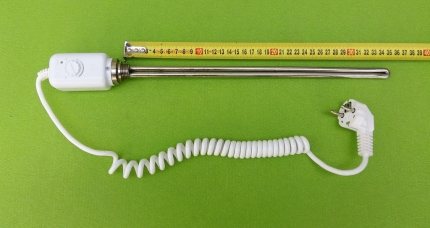

Ready-made heating elements with a regulator and their own power cord can be bought only if you are sure that the length of the wire will be sufficient
The shape and length of the tube in such devices can be any and is dictated only by design features. For example, the heating element of a micatremic heater is a coil located behind a mineral plate. When heated, the plate emits infrared heat.
The most common characteristics are:
- diameter - 5-18 mm;
- length - 200-6000 mm;
- shell material - steel, stainless steel, ceramics, copper;
- power - 0.3-2.5 kW.
Heating elements with a capacity of more than 2.5 kW are not used in household heating appliances, because the apartment wiring simply cannot withstand a greater load.
Ribbed version of electric heaters
Ribbed devices are a modification of the tubular heating element. Their feature is the presence of many thin steel plates along the entire length of the device. This design dramatically increases the area of contact with the environment, providing a high rate of heating.


Ribbed heating elements are more expensive, demanding on the volume of the working space, but provide higher consumer characteristics of heating equipment
Finned models are used mainly in heaters for air heating. They provide a rapid rise in room temperature, especially with a built-in fan.
Block designs of heating elements
The block version represents several tubular heaters combined on the basis of a single mount.
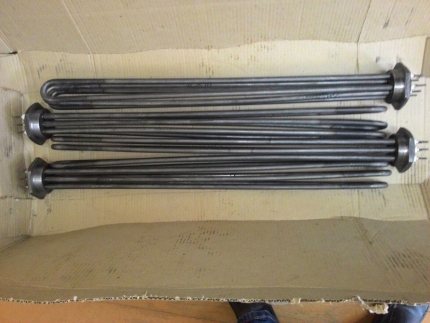

When choosing block heating elements, special attention should be paid to their power and the ability of a boiler with a pump to provide heat removal
This design is used when two factors are combined:
- The need for increased power of the device and a high rate of heating of the working medium.
- The impossibility of rapid transfer of thermal energy from the spiral to the environment due to the small area of the outer shell.
In fact, in a block heating element, the load on each heating tube decreases and the heat transfer rate increases. Such devices are part of domestic heating boilers and industrial electric heating installations.
The power of block models can be 5-10 kW, therefore, when they are placed in an apartment, an additional electrical cable must be pulled into the room.
Cartridge type devices
Cartridge heating elements have the form of a tube with one free end, which is due to the peculiarity of their installation. The outer shell is usually made of polished steel to ensure maximum contact with the surrounding material. Such tubes are tightly inserted into the corresponding hole of the heater.


The main disadvantage of cartridge heating elements is the small area of the heat-transfer surface, which requires the use of specific methods for removing heat energy
The fixation of cartridge models is carried out mainly using a flange connection. They are usually used in industry to heat the working parts of extruders.
There are other structural types of heating elements, but they are used mainly in industrial production and do not affect the topic under consideration.
Heating elements for heating boilers
The heating element can be installed in an electric or combined heating boiler. In an electric boiler, the heating element is the only source of heat, in the combined main fuel is solid - firewood, coal, briquettes.
The heating element in a solid fuel boiler plays an auxiliary role, maintaining the temperature in the absence of fuel. It is very convenient to use such boilers in summer cottages and country houses, when there is no need to constantly maintain a comfortable temperature in the house.


The boiler can be constantly switched on in the mode of maintaining the minimum temperature, which does not allow the heating system to defrost. The transition of the boiler from solid fuel to electric heating occurs automatically when a certain temperature is reached. The installation of a combi boiler requires safety precautions. Thus, the boiler must be installed in a separate room with good ventilation. Since the boiler is heavy, it must be installed on a solid concrete base. The room must have a chimney with good draft.


Additional functions of electric heaters
Above, the simplest designs of devices were considered that do not have any built-in adjusting mechanisms.


The thermoregulation unit can have mechanical or electronic automation. The latter is more accurate, but demanding on the parameters of the home electrical network.
But electric water heaters can be equipped with the simplest automation that provides the device with additional functions.
These include:
- Thermoregulation... Heating elements with a built-in thermostat for heating have a temperature sensor that is triggered when the working medium heats up to a certain level. The electric heater is adjusted from the outside of the flange.
- Anti-freezing... This function is provided by a simplified thermostat that only works when the temperature drops to 0-2 ° C. It prevents water from freezing in heating pipes, consuming a minimum of electricity.
- Turbo heating, which provides forced heating of the working environment at the initial start-up of the equipment. It must be remembered that the electrical wiring of the room must withstand a short-term increase in power.
There are not so many devices that support additional functions, because often the regulation of the operation of heating devices as a whole is carried out using a separate automation unit.
The correct choice of heating element model
Going to buy a heating element, the buyer needs to know a number of technical characteristics:
- the required power of the device;
- length, diameter and shape of the tube;
- the length of the insulating hood;
- total length;
- connection type;
- fastening method.


To calculate the power of the heating element designed to heat water of a certain volume, use the formula:
P = 0.0011 × m × (tK-tH) / T, where
P is the power of the heated element, measured in kW;
m is the mass of the heated coolant circulating in the device, in kilograms;
tH - initial temperature of water or liquid, in ° C;
tK - final temperature of water or liquid, in ° C;
T is the heating time of water or liquid.
Heating element in a heating radiator - video review:
How to choose a heating element for heating equipment?
When choosing a heating element for replacement in a water heater or in a radiator, you need to pay attention to its power, design, tube length and the availability of additional features. Therefore, before buying, you need to find out as much as possible about all its characteristics.
Calculation of the power of the device
The large power of the heating element is not always a positive quality.
When choosing, it is important to consider several factors that are related to the level of energy consumption:
- the maximum heat transfer power of the heater as a whole;
- electrical wiring capabilities;
- the volume of the room.
You cannot buy a device with a power that is more than 75% of the maximum heat transfer level of the heating equipment.
For example, there is a radiator with 10 sections, each of which gives off 150 W of heat to the air, a total of 1.5 kW. When an electric heater with a power of 2 kW is installed in it, the surface of the battery will not be able to quickly give up all the generated energy. As a result, the heating element will constantly turn off due to overheating.


The reason for the rapid breakdown of the heating element may be the wrong choice of the power of the device. As a result of systemic overheating of the coil, it burns out over time
In apartments with worn-out wiring, the constant load on the outlet should not exceed 1.5-2 kW, otherwise it may catch fire and lead to sad consequences. Therefore, before buying a heating element, you need to check the condition of the wiring and, if necessary, dismantle the old one and lay a new power grid.
When the issue with the electrics and the capabilities of the equipment is resolved, you can begin to calculate the required power to maintain a comfortable temperature in the room.
In well-insulated houses and apartments, a level of 40 W / m3 will be sufficient. And if there are gaps in the windows, the heating power should be increased to 60-80 W / m3. You can buy a specific model only after taking into account all the above energy factors.
Consideration of design features
Most heating elements have an alloy steel shell, which provides strength and resistance to corrosion. Copper devices are mainly used in water heaters, although there are no restrictions on their use in homemade radiators.


In cast iron and steel radiators, the use of heating elements made of non-ferrous metals is undesirable. This can lead to accelerated wear of materials and connections.
Also, when choosing, it is necessary to take into account the direction of the thread of the plug, which can be right or left. Different models of electric heaters also differ in the diameter of the flanges. They can range in size from 0.5 to 1.25 inches.
Usually, a short instruction is attached to a heating element of a good manufacturer, which describes its design parameters. Studying them will help you buy a device that will exactly fit your existing heating equipment.
Heating tube length
The length of the tube is one of the main characteristics that determine the efficiency of the device.
Its large length with equal power leads to an increase in the surface area of the electric heater and an acceleration of heat exchange with the working medium. This has a positive effect on the durability of the heating element and the rate of circulation of the coolant.
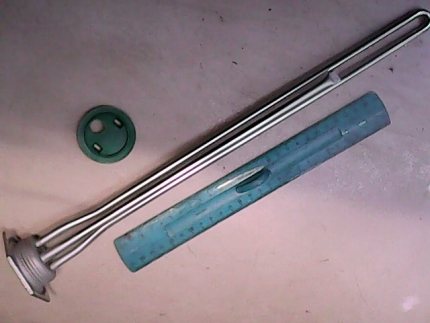

Heating elements with a long tube are ideal for installation in self-made registers, which are convenient for heating large rooms and outbuildings
It is advisable that the tube runs along the entire length of the working area of the heater, not reaching the opposite wall by 6-10 cm. This recommendation will allow you to quickly and evenly warm up the coolant.
Availability of additional functionality
It is not always necessary to overpay for additional features of heating elements. If the heater is used as an auxiliary heater and does not have its own built-in automation, then buying a model with a thermostat makes sense.
But if the radiator or electric convector has its own temperature sensors and temperature control mechanisms, additional functions will remain unclaimed.


The electronics built into the heating element plug must have safety mechanisms so that in the event of a breakdown of the control board, a fire does not occur
Therefore, it is recommended to purchase expensive electric heaters with built-in automation only if there is a clear need for such equipment. If you need an individual selection of the temperature background, it is better to buy a thermostat in an outlet, which can be used periodically.
As for the manufacturers of heating elements, their choice is not fundamental. The main suppliers are firms from Russia, Ukraine, Turkey and Italy. The quality of their products is about the same, so there is no point in overpaying for the brand.
Heating elements for heating radiators
In radiators - cast-iron or aluminum batteries - heating elements are installed to stabilize the temperature during periods when centralized heat supply is turned off or for additional heating of the room. Such heating at night can be quite beneficial if a two-rate electricity meter is installed in the house.
Heating elements for radiators have a thin flange and a narrow heating element. They are equipped with a special casing that protects against water ingress. A capillary thermostat helps to regulate heating, and two temperature sensors protect the product from overheating. Many models of modern heating elements are equipped with convenient and necessary functions: "Turbo" - for quick heating of the room and "Anti-freezing" - to prevent defrosting of the heating system. This function is intended for long-term maintenance of temperature not lower than +10 degrees.
Installing a heating element into a radiator is easy. It is necessary to remove the plug from the lower flange and screw the heating element into this hole. Then you should install the thermostat and connect the device to a grounded network. Installing heating elements in a water-based centralized heating system has many advantages:
- protects the system from freezing in case of emergency shutdown;
- allows you to accurately adjust the temperature in the room;
- economically consumes electricity due to impulse operation;
- low price with a large selection of models.



















